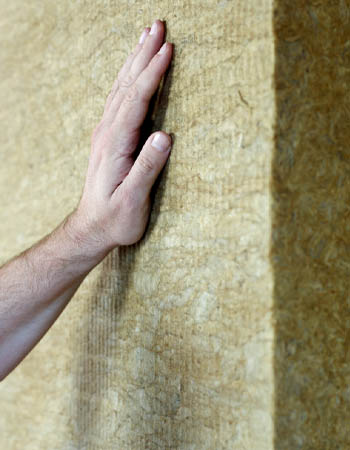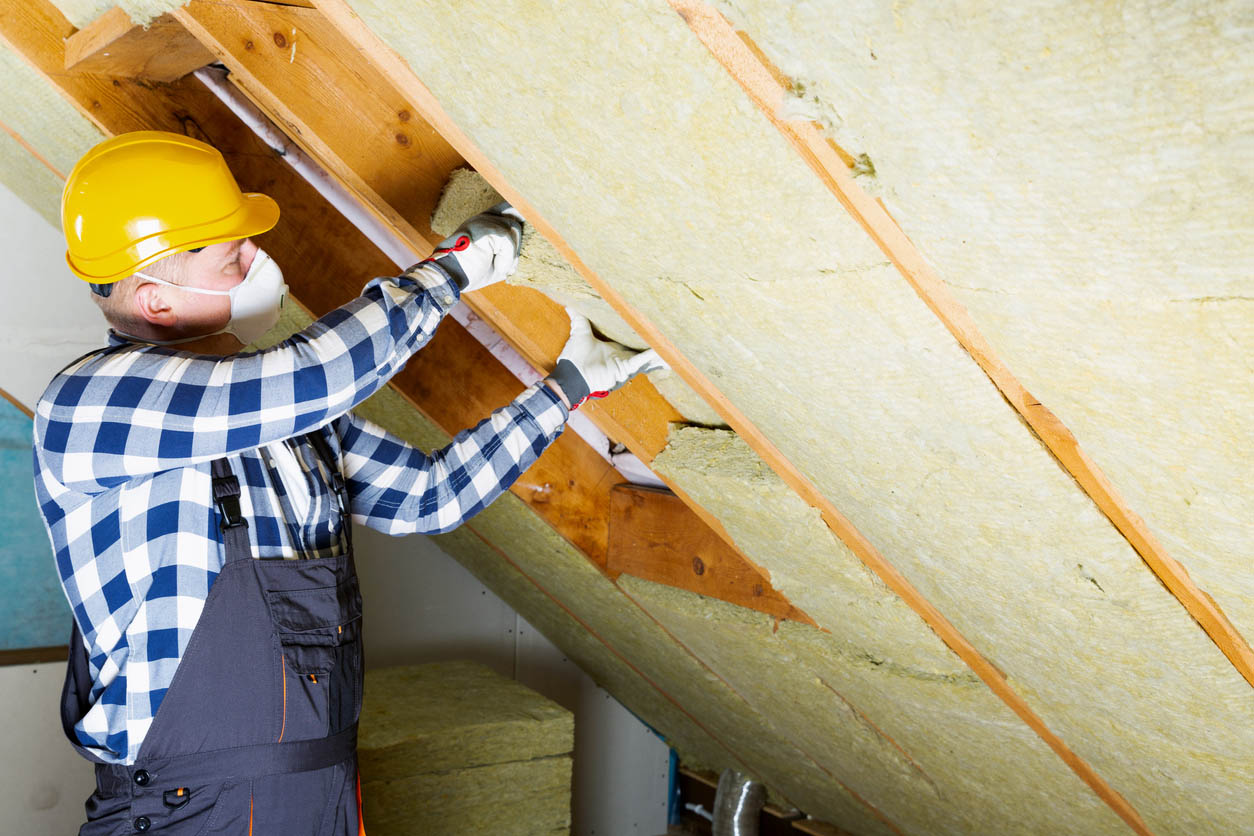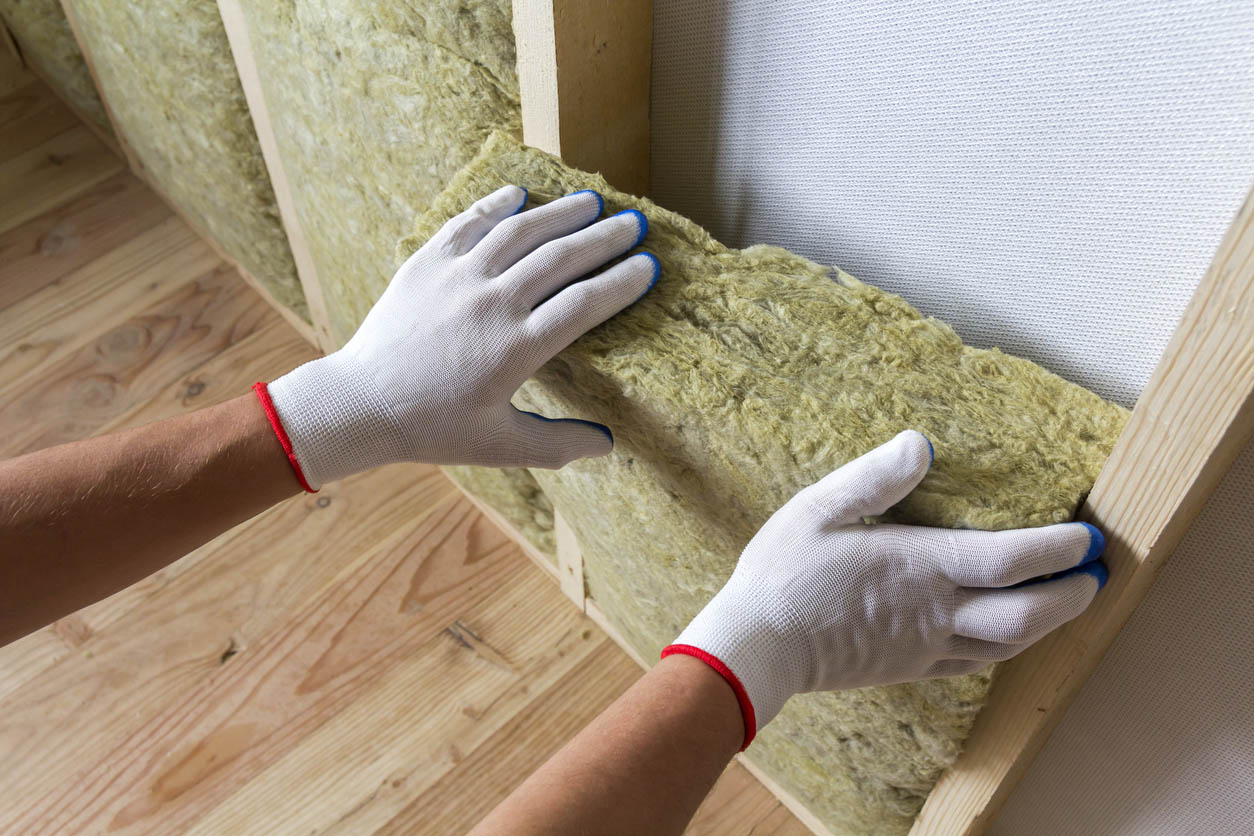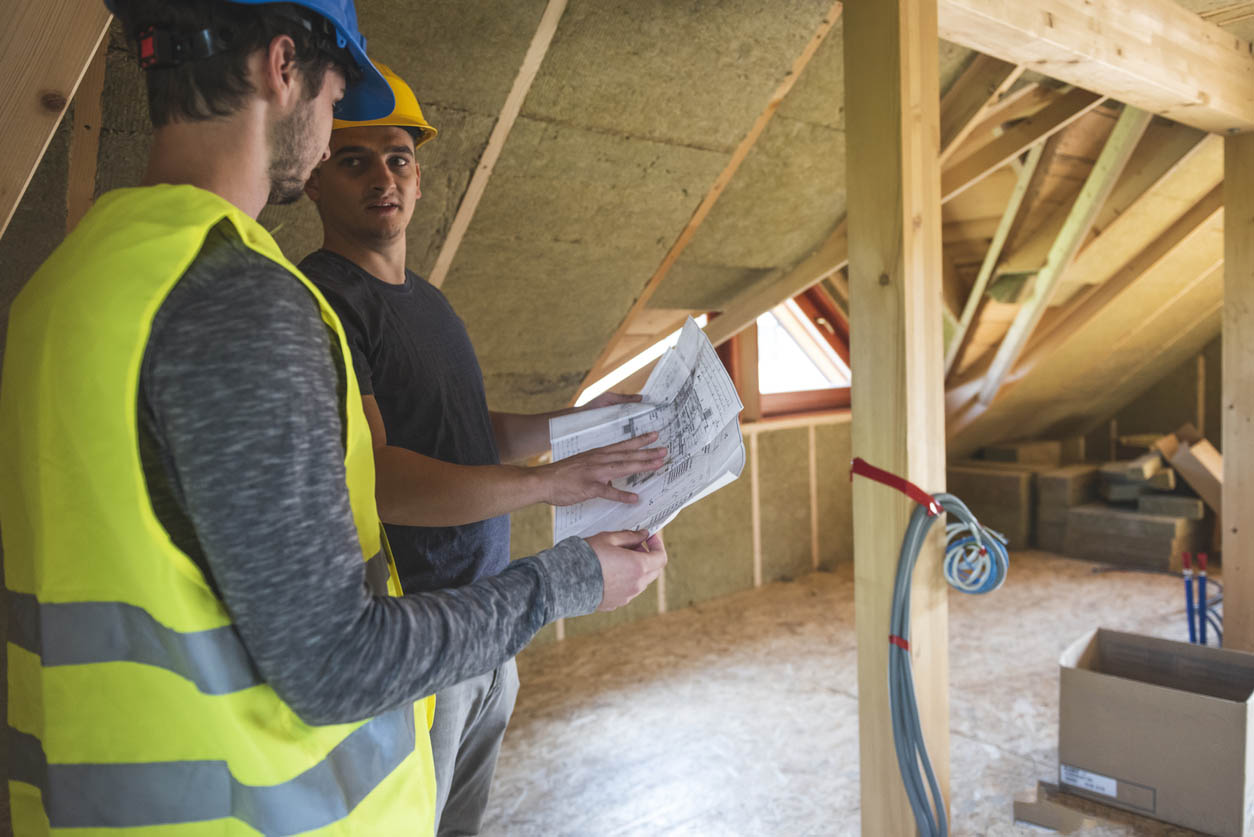We may earn revenue from the products available on this page and participate in affiliate programs. Learn More ›
- Typical Range: $1,400 to $6,300
- National Average: $2,900
If you’re experiencing a drafty house, high energy bills, attic moisture, uneven temperatures from room to room, and a constantly running HVAC system, your home may need new insulation. According to HomeAdvisor, home insulation cost options range from $1,400 to $6,300, with the national average for blown-in insulation at $2,900. Blown-in insulation costs less than batting, radiant barrier, and fiberglass insulation. The most expensive option is spray foam insulation, but it has the highest return on investment (ROI).
Insulation cost is measured per board foot, which is 1 square foot by 1 inch thick. Expect to pay between $0.25 and $2 per inch of thickness per square foot (one board foot) or $1 to $5 per square foot. The ROI on insulation is at 100 percent or more, and it’s considered one of the best investments homeowners can make to their home. Insulation warms a home in the winter and cools it in the summer by slowing down heat transfer through the walls, floor, and ceiling. Each inch of insulation supplies between a 3 and an 8 R-value. The R-value measures how well a material insulates; the higher the R-value, the better the insulation.
The cost of labor to install insulation averages between $0.25 to $0.50 per square foot. The overall labor cost depends on what type of insulation is installed. Batting insulation can be a quick installation process, while spray foam takes more time and preparation.
Factors in Calculating Insulation Cost

Calculating insulation costs depends on several factors. Prices can differ from the national average due to the type of insulation, project size, home area, labor prices, equipment, site preparation, and cleanup.
Insulation Type
There are many different types of insulation, and they all differ in cost, advantages, and uses. An insulation professional has the experience and knowledge to advise you regarding what kind of insulation will work the best in a home since some types will work better in certain areas. Some of the most common types of insulation are spray foam (open-cell foam and closed-cell foam), blanket insulation that includes batts and rolls, loose-fill or blown-in, rigid foam board, and structural insulated panels (SIPs).
Project Size
Insulation costs depend on the total square footage of the project. The area per board foot and the required R-value, as well as the project’s preparation and cleanup costs, will determine the overall insulation installation pricing. Prices can range from $0.25 and $2 per inch of thickness per square foot (one board foot) or $1 to $5 per square foot.
Room or Part of the Home
Where the insulation needs to be installed also affects overall insulation costs. For energy efficiency, a house must be insulated from top to bottom. Here are some areas of a home that need insulation, the most common type of insulation for that location, and average prices.
- Garage insulation cost. It costs approximately $0.50 to $1.25 per square foot for garage insulation (not including the garage door). The price may double if you have a professional install the insulation. The total cost can range from $1,500 to $8,000, depending on the size of the garage and the materials used. Keep in mind that attached garages only need the external walls insulated. Insulating a garage door with batts or rigid foam costs around $200 to $300 for a 9-foot-tall door.
- Floor and crawl space. Crawl space insulation costs range from $1 to $5 per square foot, depending on the type of material you choose. Many homeowners spend between $500 to $1,500. To insulate a crawl space, you can insulate the space’s ceiling (the interior floor) or the walls. The most common materials used to insulate crawl spaces are spray foam, fiberglass, and rigid board. Insulated concrete forms can be used for new construction, and they cost between $150 and $160 per square foot. This cost typically includes the price of the poured concrete wall.
- Basement insulation cost. The cost to insulate a basement usually runs between $1.50 and $2.50 per square foot. A basement rarely needs as much insulation as the rest of the house since the surrounding terrain helps keep the area cool in the summer and warm in the winter.
- Attic insulation. Homeowners can expect to pay between $1,500 and $6,000 to insulate an attic, depending on what type of materials are used. Spray insulation foam usually gets installed first, followed by batts or blown-in insulation. The attic is the most important part of your home to insulate since heat rises. Many homes have twice as much insulation in the attic as they do in the walls to protect against losing warm air.
- Roof insulation cost. Expect to pay from $1,500 to $4,500 or more for roof insulation. Roof insulation can allow you to convert an attic space into a livable area. Attic conversions typically cost $40,000, and most times, that price can be bundled with new roofing. Roof insulation can be done during or after construction. If it’s done during construction, a roofing professional can install layers of rigid foam board beneath the shingles, or you can have batting or spray foam installed along the rafters in the attic.
- Wall insulation. Wall insulation costs approximately $1 to $4 per square foot. Mineral wool and fiberglass batting costs between $1 and $1.50 per square foot to install. Newly constructed homes use reflective, rigid, spray foam, or a combination of all three, which can cost $3 to $4 per square foot.
- Pole barn insulation. It costs between $1 and $4 per square foot to insulate a pole barn. Many insulation professionals recommend spray foam or fiberglass batting with a thick polypropylene sheet. Spray foam is pricier, but it does a better job at preventing air leaks. Some homeowners will opt for a thin layer of spray foam covered with fiberglass batting to stay within their budget.
- Mobile home insulation cost. Fiberglass batting can cost between $0.25 and $1 per square foot to insulate a mobile home. If you decide on thicker materials installed by an insulation professional, the costs can range up to $3 per square foot.
Labor and Equipment
Labor costs to install insulation typically run from $0.25 to $0.50 per square foot. This price can differ from the national average depending on what type of material is used and how big the area is that needs to be insulated. Some types of insulation require specific equipment to install it. Spray foam, for example, requires special equipment to install since it comes out as a liquid and transforms into dense foam. Spray foam will cost more due to the equipment and protective gear that is needed for the project.
Site Prep and Cleanup
Site preparation and cleanup will also make up a significant portion of the overall project cost. Preparation involves any needed repairs to the walls, attic, basement, or crawl space. If there is water damage or evidence of mold or mildew, a home may require mold remediation services before a contractor can begin insulation installation. The costs for site prep will be based on the extent of the repairs and types of materials needed. Cleanup costs include removing old insulation and other materials.

Additional Costs and Considerations
When budgeting for insulation costs, there will be additional price factors and considerations beyond the basics. These include insulation removal, insulation replacement, and home air sealing.
Insulation Removal or Replacement
If the insulation professional needs to remove old insulation, there may be an additional removal and disposal fee. On average, removing the existing insulation costs between $1 and $1.50 per square foot, not including disposal fees. Removing fiberglass insulation batts is less expensive than removing blown-in attic insulation, since the latter requires special machinery or a large vacuum for removal.
Most insulation eventually loses its R-value and will need replacement. Replacing insulation costs between $2 and $7 per square foot for fiberglass and most blown-in insulation. Keep in mind that spray foam insulation cannot be removed entirely, and rigid foam boards are typically the easiest to remove. Once the old insulation is removed, a professional will seal and patch the area and refill it with the new insulation.
Home Air Sealing
It’s important to reduce air movement within a home to maintain energy efficiency. Air sealing techniques like air barriers will help prevent leakage in and out of a home. Air barriers construct pockets to block irregular air movement. They help stave off leakage in and out by using weatherproofing strips and caulking. Another air sealing technique is a house wrap. A house wrap is made from fibrous plastic wrapped around the exterior of a house to prevent air movement. Home air sealing methods are typically implemented when a house is constructed since it’s much easier to do that instead of retrofitting an existing home. The cost of air sealing runs from $350 to $600, depending on the size and scope of the project.
Insulation Cost: Types of Insulation
Depending on the type of insulation you choose, the cost to install insulation can range from $1,400 to $6,300. The average homeowner typically pays around $2,900 for insulation costs. Here are some of the most common types of insulation.
Spray Foam
Spray foam insulation (SPF) costs between $0.50 to $2 per board foot. This price can vary if you fill gaps and leaks inside existing walls. Spray foam insulation is composed of plastic foam materials to deter air movement and supply thermal insulation. Spray foam insulation is an excellent way to increase the R-value and insulate a home. When spray foam insulation is professionally installed, it can save $500 or more a year in heating and cooling costs—but keep in mind that not all insulation professionals offer this service. While spray foam insulation is more expensive up front, it can save more in the long run. There are two types of spray foam insulation: open-cell and closed-cell. The “cell” refers to the bubbles that make up the foam.
- Open-cell. Open-cell spray foam insulation costs between $0.35 and $0.55 per board foot. Sometimes called half-pound, this type of insulation is an excellent air barrier, but it’s not a water vapor barrier. Open-cell spray foam has bubbles that are intentionally left open. This insulation is softer, more flexible, and less dense than closed-cell foam insulation. The R-value of open-cell insulation is about 3.5 per inch. It’s designed to expand about 3 inches. Only one application of open-cell spray foam insulation is feasible in standard-size walls.
- Closed-cell. Closed-cell spray foam usually costs $1 to $2 per board foot. Closed-cell insulation excels as an air and water vapor barrier. The cells in this type of spray foam are thickly packed to ensure that no moisture or air can infiltrate a home. Because of the density, it is also more resistant to pests than open-cell spray foam insulation. Closed-cell foam has an R-value of 6 to 7 per inch, making it ideal for homes in extreme climates.
Blown-In
Blown-in insulation typically costs $1,000 to $2,100. Also known as loose-fill insulation, blown-in insulation is usually installed in attics, enclosed existing walls, or open-wall cavities. Blown-in insulation comes in three types: fiberglass, cellulose, and mineral or rock wool. You can buy cellulose blown-in insulation in reclaimed or recycled varieties.
Batt
Fiberglass batt insulation is the most common type of insulation. It comes in rolls or batts, and it’s the most economical form of insulation. While it’s made primarily of fiberglass, it also can contain plastic fibers, mineral wool, or natural fibers. It usually costs between $0.30 and $1.50 per square foot or between $1,000 and $2,400 on average. When an insulation professional installs it correctly, fiberglass batt insulation can improve energy efficiency by 25 to 30 percent.
Rigid Foam Board
Rigid foam insulation in walls will cost between $0.90 to $1.88 per square foot on average. Rigid foam boards trap gases and air to prevent heat flow. It’s commonly used to insulate unvented roofs with low slopes, ceilings, and floors, but it can also be used in foundation walls. Rigid foam boards come in different thicknesses, and an insulation professional can determine the appropriate thickness for the home and location. Foam boards are made from polystyrene, polyisocyanurate, and polyurethane materials. These boards provide a high level of insulation for a thinner board. The boards can be used on the interior and exterior walls, but they need to be coated with approved materials for fire safety.
Fiberglass
Fiberglass insulation is made of fine glass fibers and can be found in rolls or batts as well as blown-in insulation. It’s commonly used to insulate wall cavities, floors, crawl spaces, and walls. Fiberglass is a good insulation material because of the air pockets between the fibers. If the fiberglass is compressed, it will lose its insulating properties. Some people maintain that fiberglass is hazardous to their health and opt for an eco-friendly alternative such as old denim, cork, sheep’s wool, or recycled plastic. An insulation professional will tell you what kind of insulation will work the best in your home. Fiberglass insulation has an R-value of 2 to 2.5 per inch of depth.
Radiant
Reflective or radiant barrier foundation usually costs between $700 and $2,900. Depending on the thickness and brand, materials cost $0.25 to $1 per square foot. To insulate a 500-square-foot attic, expect to pay between $125 and $500; double-sided radiant barriers are more expensive. Professional installation will add approximately $575 to $750 to the overall total. Radiant barriers technically don’t have an R-value because the sheeting reduces heat gain by re-emitting radiant heat instead of absorbing it. This type of insulation is typically used in warmer climates with packed insulation to lower cooling costs.

Insulation Cost: Signs You Need New Insulation
While there is no set timeline for replacing your home’s insulation, there are a few red flags that signal when new insulation is necessary. If you notice any of the following issues with your home, chances are you need new insulation.
Increased Energy Costs
If you notice that your energy bills are getting more expensive, your home’s insulation may not be as efficient as it should be. If you compare this year’s utility bill to last year’s bill, you will be able to track an increase in heating and cooling usage. If your heating and cooling system is working harder to maintain a consistent temperature, there’s a good chance that the insulation needs to be replaced.
Uneven Temperatures Between Rooms
It’s common for insulation to fail in one area before it fails in another. This creates drafty spots and uneven temperatures throughout your home. If a bedroom is much colder and draftier in the winter than the living room, it’s safe to say that the insulation in the bedroom needs some attention.
Moisture in the Attic
If there are signs of water or moisture in the ceiling or attic, it may be a sign that a home is under-insulated or the insulation is damaged. High temperatures and extreme heat can create condensation, which can cause moisture to pool. Pooling water in the attic or ceiling can produce mold and mildew, posing severe health and safety risks.
Heating and Cooling Systems Running Consistently
If the heating and cooling system in a home is constantly running, it can signify that the insulation isn’t performing as it should. A home’s insulation should regulate a consistent temperature. If the indoor temperature changes drastically once the furnace or air conditioning unit turns off, the insulation may be to blame.
Drafts in the Home
Poorly performing insulation not only wastes energy but it increases energy costs. It can also disrupt the whole family’s comfort by allowing drafts. Insulation that’s old and not working correctly doesn’t provide a barrier for air leaks and will allow the cold outside air into a home.
Home’s Inhabitants Frequently Suffer From Allergies or Illnesses
Damaged or aging insulation is a breeding ground for bacteria, mold, and other allergens. If you or a family member has chronic allergies or respiratory illnesses, the insulation may be the culprit. Ensure that you rule out other potential sources of mold and allergens throughout the home as well.
Pest Issues
Insulation that isn’t installed correctly can soon become a cozy home for pests and rodents. They can leave their urine and droppings behind that will break down the insulation and become a serious health issue. Contaminated and damaged insulation will need to be removed and replaced.
Insulation Shows Signs of Breakdown
Old insulation that is compressed, wet, thinning, falling down, or shifting will not do its job properly. Aging insulation, small animals, insects, harsh weather conditions, dirt, and dust can degrade insulation, making it ineffective. To make sure your home is energy efficient, remove and replace any old and failing insulation.
Insulation Cost: Benefits of Installing New Insulation
Inhabitants can reap the benefits of properly installed and high-performing insulation year-round. New insulation for walls, floors, attic, or basement is an excellent investment for a home. Here’s why.
Temperature Control
Insulation keeps a home cool in the summer and warm in the winter. By installing new insulation, you won’t have uneven temperatures throughout the house, and the heating and cooling system won’t have to work overtime.
Energy Savings
A home that is improperly insulated can lose between 20 and 30 percent of its energy. Air leaks around windows and doors and in the basement and attic will cause the heating and cooling system to work overtime. A constantly running system means a more expensive utility bill. Consider getting an energy audit of your home to discover where your home may lose energy. Energy companies offer this service to establish how to improve a home’s energy efficiency. This can help save from 5 to 30 percent of heating and cooling costs yearly.
Sound Insulation
A well-insulated home is a quieter home. Insulation helps absorb the noises and sounds of everyday living. When insulation is used between drywall and flooring, it can help soundproof rooms.
Carbon Footprint
Since insulation helps reduce the amount of energy used in the home, new insulation can help reduce emissions and environmental impact. By installing the proper insulation for your home, you can reduce your carbon footprint while keeping your home comfortable.
Return on Investment
If you’re considering selling your home, new insulation is a big selling point for potential buyers. One of the best upgrades a homeowner can make is to boost the insulation. With a return on investment of 100 percent or more, new insulation is one of the best investments for a home of any age.

Insulation Cost: DIY vs. Hiring a Professional
Some insulation types can work for a DIY project, but there are plenty of disadvantages and potential pitfalls, making this job a better choice for a professional. A non-professional installation can take extra time, and there’s a high overhead associated with the required materials. Plus, insulation makes a lot of mess. When installing fiberglass batts, it’s critical not to compress or flatten any of the insulation. If the air pockets in the fibers are compressed, the insulation will no longer have the ability to effectively insulate or maintain its R-value. Protective gear is necessary to work with fiberglass insulation as it’s dangerous to inhale or touch the fibers. A DIYer will need a dust mask, gloves, goggles, and full-coverage clothing or a protective jumpsuit. Keep in mind that you need more than just the insulation if you want to install insulation yourself. Other materials can include nails, hammers, caulking, and sealing glue. The prices of these items will add to the overall cost of the insulation project. Spray foam insulation needs to be installed by a professional due to the specialized skills and equipment required for a proper install. An insulation contractor should only do blown-in insulation for an attic or roof.
How to Save Money on Insulation Cost
Insulation costs can be high, and the additional costs associated with the project can quickly add up. One way to save on insulation costs is to install the cheapest insulation material, but there are other ways to save without compromising quality.
- Get multiple estimates. Always get three to five estimates from reputable insulation contractors in your area. Ensure the estimate includes the type of insulation, the price per square foot, and the R-value.
- Look for rebates. Search online for local or federal rebates when you install new insulation in your home. An insulation professional should also be able to inform you of available rebates.
- Time it right. Look for pricing in the late fall or early winter. This is typically the slow time for insulation contractors, and prices may dip during this time of year.
- Ask for an energy audit. Some energy companies may provide a free energy audit so you can determine precisely where you need new insulation and what type to install.
- Remove it yourself. You can save money on removal costs by removing the old insulation yourself. Be sure to check with your city so you can abide by the local disposal requirements. You can also ask if your insulation contractor will remove it for free or for a discount.
Questions to Ask About Insulation Cost
Asking a professional the right questions about insulation costs can minimize miscommunication, save money, and get the desired results. Here are some questions to ask an insulation professional.
- Are you licensed and insured?
- Do you have references?
- What warranty or guarantee do you offer?
- Who will install the insulation?
- What kind of personal protective gear will the installers wear?
- Do you have workers’ compensation insurance?
- What type of insulation do you recommend for my home?
- What about a vapor barrier and ventilation?
- How long will the project take?
- If my home needs repairs or improvements, will you be the one to do them?
FAQs
Deciding on new insulation while staying within your budget can be a daunting process. Here are some frequently asked questions about insulation costs to help guide you in your decisions.
Q. How much does it cost to insulate a 1,500-square-foot house?
It costs between $1 and $5 per square foot for insulation, depending on the type. A 1,500-square-foot home could cost between $1,500 and $7,500 to insulate. The amount of insulation needed varies from home to home.
Q. How much does a roll of insulation cost?
The cost of a single roll of insulation varies according to its R-value. It costs between $0.80 and $1.00 per square foot. Insulation comes in standard-sized rolls between 17.5 feet and 80 feet.
Q. What is the best type of insulation material?
Certain types of insulation work better in certain areas than others. Batt insulation works best in attic roofs, walls, and floors. Foam board is primarily used in walls, and spray foam is best used in floors, roofs, and attic walls. Blown-in insulation is used for enclosed walls and wall cavities, and structural insulated panels (SIPs) work best for unfinished walls, floors, ceilings, and roofs for new construction. A professional insulation contractor will determine the best insulation for your home’s needs.


